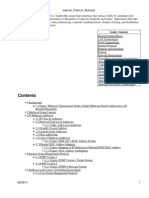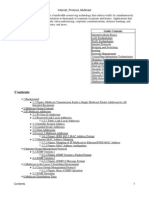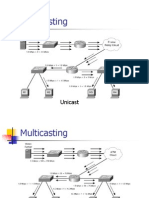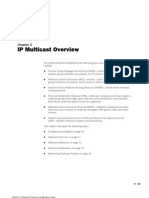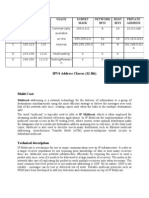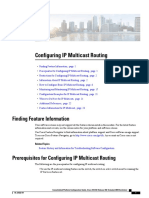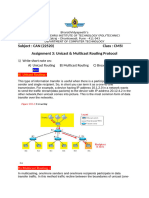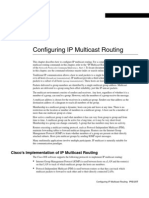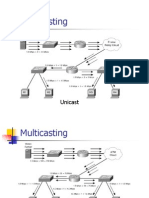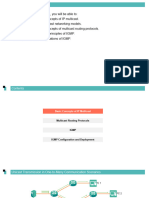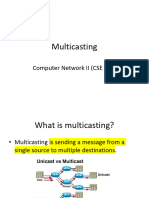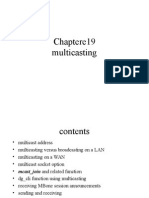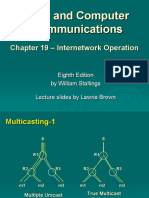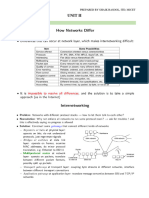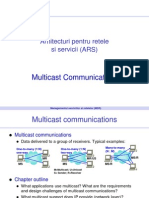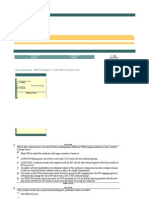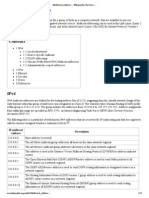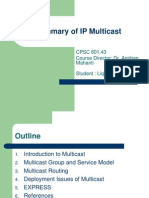Using Ip Multicast With Vmware® Esx 3.5: Technical Note
Using Ip Multicast With Vmware® Esx 3.5: Technical Note
Uploaded by
mmonce8916Copyright:
Available Formats
Using Ip Multicast With Vmware® Esx 3.5: Technical Note
Using Ip Multicast With Vmware® Esx 3.5: Technical Note
Uploaded by
mmonce8916Original Title
Copyright
Available Formats
Share this document
Did you find this document useful?
Is this content inappropriate?
Copyright:
Available Formats
Using Ip Multicast With Vmware® Esx 3.5: Technical Note
Using Ip Multicast With Vmware® Esx 3.5: Technical Note
Uploaded by
mmonce8916Copyright:
Available Formats
Technical Note
Using IP Multicast with VMware® ESX 3.5
VMware ESX 3.5
IP multicast is a popular protocol implemented in many applications for simultaneously and efficiently
delivering information to multiple destinations. Multicast sources send single copies of information over the
network and let the network take responsibility for replicating and forwarding the information to multiple
recipients.
IP multicast is one of three commonly used methods of forwarding packets on an IP network. These methods
are:
Unicast—One‐to‐one packet delivery from a source to a single destination. This is the most common and
familiar form of traffic, with the destination IP address representing a single unique destination.
Broadcast—Packet delivery to all nodes within an IP network. The destination address for an IP broadcast
is all binary ones in the host portion of the destination IP address.
Multicast—Packet delivery to a group of destinations denoted by a multicast IP address. Membership of
this group is coordinated through the Internet Group Management Protocol (IGMP).
A fourth method, called anycast, is rarely used.
This paper provides an overview of IP multicast and support for this protocol in VMware ESX 3.5. It covers
the following topics:
“IP Multicast Address Space” on page 1
“Layer 2 Multicast Addressing” on page 2
“IP Multicast Groups” on page 2
“IGMP Versions” on page 2
“Operation of Multicast on a Physical Network” on page 3
“Operation of Multicast on an ESX Virtual Switch” on page 3
“Considerations for VMotion” on page 4
“NIC Teaming Considerations” on page 6
“IP Multicast Parameters on ESX” on page 7
“Physical Switch and Router Considerations” on page 8
IP Multicast Address Space
IP multicast destinations are represented by a group IP address from the old Class D IP address space between
224.0.0.0 and 239.255.255.255. Each individual address specifies a multicast group.
The IP multicast address space is broken into three broad address ranges. Well‐known addresses within these
address ranges are administered by the Internet Assigned Numbers Authority.
Copyright © 2008 VMware, Inc. All rights reserved. 1
Using IP Multicast with VMware® ESX 3.5
224.0.0.0–224.0.0.255—reserved link local addresses. These are used by network protocols such as OSPF
and DHCP on local network segments. These are not routable but are locally forwarded without joining.
Because these addresses are reserved, do not use them for manual testing.
224.0.1.0–238.255.255.255—globally scoped addresses. These addresses have global significance and can
be used over the Internet and between organizations. Some addresses are reserved for applications such
as NTP (224.0.1.1).
239.0.0.0–239.255.255.255—limited scope addresses. These addresses have local significance and are
restricted to local groups or organizations.
Layer 2 Multicast Addressing
An IP multicast address is a Layer 3 IP address. In order to receive IP multicast packets, the NIC must be
programmed to accept traffic destined to the multicast MAC address that correspond to a given multicast IP
address. A multicast MAC address is created by setting the broadcast‐multicast bit (bit 0, octet 0) in the
destination 48‐bit MAC address.
The Internet Assigned Numbers Authority has allocated the first half of the block of Ethernet MAC addresses
starting with 01:00:5E for multicast addresses. This creates the range of available Ethernet multicast MAC
addresses from 01:00.5E:00:00:00 through 01:00:5E:7F:FF:FF. This allocation allows for 23 bits in the Ethernet
address to correspond to the IP multicast group address. The mapping places the lower 23 bits of the IP
multicast group address into these available 23 bits in the Ethernet address. Because the upper five bits of the
IP multicast address are dropped in the mapping from IP address to MAC address, the resulting Ethernet
multicast address is not unique to a single IP multicast group address. In fact, 32 different multicast group IDs
all map to the same Ethernet address.
An example:
Consider an IP Multicast group address of 224.1.5.6 The low order 23 bits of this IP address are
x0000001:00000101: 00000110 in binary format or 010506 in hexadecimal format. The resulting multicast MAC
address is 01:00:5E:01:05:06.
Because only the lower 23 bits are mapped, the address is not unique. The IP multicast group addresses of
224.129.5.6, 225.1.5.6, 225.129.5.6, and so on map to the same multicast MAC address. In other words, multiple
IP multicast groups can use the same multicast MAC addresses.
IP Multicast Groups
IP multicast group addresses can be dynamically or statically assigned to applications. Hosts use IGMP to
register dynamically for a multicast group. Once registered, the host receives traffic sent to that multicast
group. To keep multicast group memberships up‐to‐date and prevent forwarding traffic unnecessarily,
multicast routers periodically query hosts for their interest in receiving multicast traffic using IGMP
membership query messages. The frequency of the IGMP membership query messages is a tunable parameter
in most multicast routers. By default, it is typically sent every 60 seconds. Hosts respond to these queries with
IGMP membership report messages that list the multicast groups for which they wish to receive traffic. If there
is no response to three consecutive IGMP membership query packets for a particular group, the multicast
router stops forwarding traffic to that group.
IGMP Versions
Three versions of IGMP are defined by the IETF—versions 1, 2, and 3.
IGMP V1—Defined in RFC 1112 (August 1989). Superseded by V2. Rarely implemented.
IGMP V2—Defined in RFC 2236 (November 1997). Superseded by V3. Some implementations still in use.
IGMP V3—Defined in RFC 3376 (October 2002). Most widely implemented and default in current
operating system products (for example, Windows Server 2003 and Red Hat Enterprise Linux 5).
Copyright © 2008 VMware, Inc. All rights reserved. 2
Using IP Multicast with VMware® ESX 3.5
Note that IGMP V2 and V3 differ in the structure of the IGMP membership reports. A guest operating system
using IGMP V2 responds with a separate IGMP V2 membership report for each group to which it has
subscribed. A guest operating system using IGMP V3 bundles the individual groups as vectors in a single
IGMP V3 membership report. IGMP V3 is more economical than V2 and preferred in environments with a
large number of group memberships.
Operation of Multicast on a Physical Network
Physical Layer 2 switches limit the flooding of multicast traffic out all ports through a mechanism called IGMP
snooping. IGMP snooping involves the switch listening for IGMP control information. It uses this information
to determine which switch ports are interested in receiving multicast packets.
In place of IGMP snooping, some Cisco switches and routers allow the optional use of Cisco Group
Management Protocol (CGMP) between the switch and a multicast router. With CGMP, the multicast router
explicitly tells switches which ports belong to which multicast groups.
The selection of IGMP snooping or CGMP in the physical switches is transparent to ESX.
IP multicast operation on ESX is independent of the Layer 3 IP multicast routing protocol. It does not matter
whether PIM (dense or sparse), DVMRP, or any other protocol is used.
Operation of Multicast on an ESX Virtual Switch
IP multicast is fully supported by VMware ESX. The implementation and operation of multicast, however,
differs slightly from the implementation and operation in a physical switch.
A virtual switch (vSwitch) does not need to perform IGMP snooping to learn which virtual machines have
enabled IP multicast. ESX dynamically learns multicast membership because it has authoritative knowledge
of the attached virtual NICs (vNIC). When a vNIC attached to a virtual machine is configured for multicast,
the vSwitch learns the multicast Ethernet group addresses associated with the virtual machine. When the
virtual machine joins an IP multicast group, the virtual machine first converts the group to an Ethernet
multicast group based on the IP address. The virtual machine then programs its own NIC filter on the vNIC
to subscribe to the multicast traffic. The vNIC passes the multicast registration information down to the
vSwitch through the hypervisor to update the multicast tables on the vSwitch and enable forwarding of frames
for that IP multicast group to that virtual machine.
Figure 1 shows an overview of the IP multicast message flow. The virtual machines use IGMP to join and leave
multicast groups. Adjacent multicast routers send periodic membership queries to a well known link local
multicast address (224.0.0.1) on the local network. ESX allows these to pass through to the virtual machines.
Virtual machines with multicast subscriptions respond to the multicast router with one or more IGMP
membership reports detailing the group memberships to which they are subscribed. Layer 2 switches in the
network path use IGMP snooping to learn which interfaces require forwarding of multicast group traffic.
Figure 2 shows a network trace of the IGMP message flow between a virtual machine and the adjacent
multicast router.
Copyright © 2008 VMware, Inc. All rights reserved. 3
Using IP Multicast with VMware® ESX 3.5
Figure 1. Overview of IGMP Message Flows in an ESX Environment
“Fake” IGMP VM0 VM1
membership
query from ESX App App
after VMotion
OS OS
vSwitch
IGMP Periodic
IGMP
membership IGMP
reports from membership
virtual machine queries from
multicast router
L2 switches
with IGMP
snooping
Local
multicast
routers
Multicast
routing
protocols
such as
PIM
Figure 2. Trace Showing Periodic IGMP V2 Membership Queries from Multicast Router and IGMP
Membership Reports from Virtual Machine
Considerations for VMotion
When a virtual machine that subscribes to multicast traffic moved to a different physical host using VMotion,
the multicast vNIC information is retained with the virtual machine as it moves. The destination ESX host
immediately knows the multicast group memberships of that virtual machine. If the vSwitch uplink in the
destination ESX host is already receiving multicast traffic for that group (because of membership by another
virtual machine), the multicast traffic flow continues to that virtual machine. What happens from that point
depends upon the ESX release level.
VMotion with Releases Up To and Including ESX 3.5 Update 1
If the destination ESX host is not receiving multicast traffic for the desired group, it must wait for the periodic
IGMP group membership query from the multicast router and the corresponding IGMP response from the
virtual machine. Using IGMP snooping, the physical switches learn the new location of the virtual machine
and forward multicast traffic to the corresponding host vSwitch. The default time for the periodic IGMP
membership query from the multicast router is 60 seconds. This means a virtual machine might have to wait
as long as 60 seconds after VMotion to resume receiving multicast traffic.
Copyright © 2008 VMware, Inc. All rights reserved. 4
Using IP Multicast with VMware® ESX 3.5
For ESX 3.5 Update 2 and Later Releases
In ESX 3.5 Update 2 and later releases, ESX accelerates the convergence time of multicast traffic using the
following procedure:
1 As soon as VMotion has moved the virtual machine to the destination host, ESX sends a fake IGMP
membership query to the virtual machine to solicit group membership information.
2 If the virtual machine is a member of any multicast groups, it immediately responds with an IGMP
membership response detailing its multicast group memberships.
3 Using IGMP snooping, the physical switches update their multicast membership tables and forward
multicast traffic for the matching multicast groups to the ESX host.
Figure 3 shows the trace summary of the fake queries and the resulting responses from the virtual machine.
By default, ESX sends two IGMP V3 membership queries using a source IP address of 10.0.0.0 and a source
MAC address of 00:00:00:00:00:00. The procedure for changing the IGMP version, number of queries, and
source IP address is described later in this document.
Detailed trace entries for the IGMP V2 and V3 membership queries are shown in Figure 4 and Figure 5. The
corresponding IGMP V2 and V3 membership reports are shown in Figure 6 and Figure 7.
Figure 3. Trace Entries Showing Fake IGMP V2 Membership Queries Sent by ESX to the Virtual Machine
after VMotion with Corresponding Responses from the Virtual Machine
Figure 4. Trace Entry Detail of a Fake IGMP V2 Membership Query Sent by ESX to the Virtual Machine after
VMotion
Figure 5. Trace Entry Detail of a Fake IGMP V3 Membership Query Sent by ESX to the Virtual Machine after
VMotion
Copyright © 2008 VMware, Inc. All rights reserved. 5
Using IP Multicast with VMware® ESX 3.5
Figure 6. Trace Entry Detail of a Periodic IGMP V2 Membership Report Sent by a Virtual Machine
Figure 7. Trace Entry Detail of a Periodic IGMP V3 Membership Report Sent by a Virtual Machine
NIC Teaming Considerations
All ESX NIC teaming algorithms are supported with IP multicast. However, failures of members within a NIC
team can interrupt delivery of multicast traffic.
The following sections describe some special considerations that apply to each algorithm under failover
situations.
IP-Hash
A NIC team using IP hash requires a corresponding Layer 2 port channel or EtherChannel on the adjacent
physical switch—or multiple switches if some form of multichassis EtherChannel (MEC) is used. An
EtherChannel is a single logical link comprising multiple physical links. As long as at least one link in the team
is still active, failures do not affect the flow of multicast traffic other than the possible loss of some packets that
are in transit when the failure occurs.
Originating Virtual Port ID
Originating virtual port ID is the most common and best practice method of NIC teaming for virtual machines.
Under originating virtual port ID, each vNIC is mapped to a specific vmnic (physical NIC) in the team for both
outgoing and incoming traffic. This mapping applies to all external unicast, multicast, and broadcast traffic.
If a failure occurs on a link within a NIC team, the virtual machines that were mapped to the failing vmnic are
reallocated to remaining active vmnics within the team. If Notify Switches (the default) is selected in the
policy definition for that NIC team, ESX generates a reverse ARP (RARP) to notify the physical switches of the
new location (link or vmnic) of the MAC address for the virtual machine’s vNIC and enable immediate
resumption of unicast traffic to the virtual machine.
However, this does not update the delivery of multicast traffic to the ESX host from the physical switch. The
physical switch updates its multicast tables and continues delivery only when, through IGMP snooping, it
detects an IGMP membership report from the virtual machine to the network. Virtual machines respond with
IGMP membership reports when solicited by a periodic IGMP membership query from an adjacent multicast
router. In most multicast router implementations, IGMP queries are sent every 60 seconds by default.
Copyright © 2008 VMware, Inc. All rights reserved. 6
Using IP Multicast with VMware® ESX 3.5
In ESX 3.5 Update 1 and prior release, virtual machines might have to wait as long as 60 seconds for multicast
traffic to resume. To reduce the maximum wait time, follow the procedure in “Physical Switch and Router
Considerations” on page 8.
NOTE In some circumstances multicast traffic resumes immediately after failure of a member in the NIC team.
This occurs if, after failover, the virtual machine is remapped to another vmnic in the NIC team already
receiving multicast traffic for that multicast group—that is, another virtual machine was receiving that
multicast group traffic through that vmnic.
In ESX3.5 Update 2 and later releases, the ESX vSwitch sends a fake IGMP membership query to the affected
virtual machines immediately after a NIC teaming failure event. This query solicits an IGMP membership
report from the virtual machines to the multicast router and updates any intermediate switches with IGMP
snooping so multicast traffic can resume immediately on the new or changed member of the NIC team. The
fake IGMP process is the same as that described in the section on VMotion.
MAC Hash
Under MAC hash, each MAC address associated with vNICs is mapped to a specific vmnic (physical NIC) for
outgoing and incoming traffic. The same multicast considerations apply for MAC hash as for originating
virtual source port ID, described above.
Explicit Failover Order
Under explicit failover order NIC teaming, vmnics in the standby list are changed to active after a failure is
detected on any of the active adapters. The same multicast considerations apply for explicit failover order as
for originating virtual source port ID, described above.
IP Multicast Parameters on ESX
ESX allows you to change some of the IP multicast parameters to suit your environment. The parameters apply
to all virtual machines on the affected ESX host.
The panel shown below in Figure 8 is available from a VMware Infrastructure Client with direct connectivity
to the ESX host or via vCenter. The procedure is as follows:
1 Select Inventory > Hosts and Clusters.
2 Select the Configuration tab.
3 Select Advanced Settings in the Software panel. The Advanced Settings panel appears.
4 Select Net from the list and scroll to the bottom.
5 Make required changes and click OK.
Changes are immediate and do not require a reboot of the ESX host.
Copyright © 2008 VMware, Inc. All rights reserved. 7
Using IP Multicast with VMware® ESX 3.5
Figure 8. Advanced Settings Panel on VI Client Showing Configurable Parameters for IP Multicast on ESX
You can set the following parameters:
IGMP Version—Default is IGMP V3. This parameter determines whether IGMP V2 or IGMP V3
membership queries are sent to the virtual machine after it is moved with VMotion. Virtual machines with
an IGMP V2 implementation might ignore IGMP V3 queries. However, IGMP V3 hosts should respond
to IGMP V2 queries. This is an ESX host parameter and thus affects all virtual machines on that host. If
you have some virtual machines with V2 and some with V3, set this parameter to the lowest common
denominator of V2. Otherwise, leave this at V3.
IGMP Queries—Default is 2. This specifies how many IGMP V2 or V3 membership queries are sent to
the virtual machine immediately after it is moved with VMotion to solicit the IGMP membership reports.
Two queries are sent by default to reduce impact of any isolated packet drops.
IGMP Router Address—Default is 10.0.0.0. This is the source IP address for the fake IGMP membership
queries sent by ESX to the virtual machine after it is moved with VMotion. Leave this as is unless the
virtual machine has some additional filtering to exclude packets from this address.
Physical Switch and Router Considerations
Most multicast routers send V2 or V3 membership queries on multicast‐enabled networks every 60 seconds.
When using ESX 3.5 Update 1 and earlier releases, multicast traffic flow to a virtual machine can be interrupted
after either of the following events:
Movement with VMotion
NIC failure when using one of originating virtual port ID, MAC hash, or explicit failover as a NIC teaming
policy.
After one of these events, multicast traffic flow resumes only after the virtual machine responds to the periodic
IGMP membership query with an IGMP membership report. Under default conditions, this could take as long
as 60 seconds.
To reduce the convergence time, consider the following changes:
Reduce the IGMP query interval on the multicast router for that particular network.
Reduce the IGMP query maximum response time. This parameter indicates the maximum tolerated
response time for an IGMP membership report after an IGMP membership query from a multicast router.
Copyright © 2008 VMware, Inc. All rights reserved. 8
Using IP Multicast with VMware® ESX 3.5
An extract from a Cisco Catalyst 4948 IOS configuration is shown below. This example shows an IGMP query
interval of 10 seconds and maximum response time of 1 second.
interface Vlan20
ip address 192.168.20.1 255.255.255.0
ip pim sparse-mode
ip igmp query-max-response-time 1
ip igmp query-interval 10
Altering the query interval is not necessary for ESX 3.5 Update 2 and later releases because the ESX vSwitch
sends fake IGMP membership queries immediately after a movement with VMotion or a NIC failure event to
solicit an IGMP membership report and minimize the multicast traffic convergence time.
Troubleshooting from the Physical Switch
Multicast‐capable physical switches typically offer a number of commands from the command line interface
showing the status of multicast on the switch. Consult your switch documentation for the available command
set.
For example, the show ip igmp snooping statistics command on a Cisco Catalyst 6500 yields the
following output showing which VLANs and switch interfaces are enabled for multicast traffic.
Cisco-6509-A#show ip igmp snooping statistics
Snooping statistics for Vlan3000
#channels: 2
#hosts : 6
Source/Group Interface Reporter Uptime Last-Join Last-Leave
0.0.0.0/239.255.255.253 Vl3000:Gi3/2 10.115.172.104 02:29:58 00:01:37 -
0.0.0.0/239.255.255.253 Vl3000:Gi3/2 10.115.172.105 02:30:56 00:00:54 -
0.0.0.0/239.255.255.250 Vl3000:Te7/4 10.115.172.137 02:30:56 00:00:54 -
0.0.0.0/239.255.255.253 Vl3000:Te7/4 10.115.172.115 02:31:00 00:00:53 -
0.0.0.0/239.255.255.253 Vl3000:Po2 10.115.172.117 02:31:00 00:00:53 -
0.0.0.0/239.255.255.253 Vl3000:Po11 10.115.172.100 02:31:02 00:00:54 -
Snooping statistics for Vlan3001
#channels: 4
#hosts : 12
Source/Group Interface Reporter Uptime Last-Join Last-Leave
0.0.0.0/224.0.6.127 Vl3001:Te7/3 10.115.173.26 02:30:54 00:00:00 -
0.0.0.0/239.255.255.253 Vl3001:Te7/3 10.115.173.22 02:28:00 00:01:07 -
0.0.0.0/239.255.255.253 Vl3001:Te7/3 10.115.173.23 02:26:00 00:00:57 -
0.0.0.0/239.255.255.253 Vl3001:Te7/3 10.115.173.26 02:30:00 00:02:32 -
0.0.0.0/239.255.255.253 Vl3001:Te7/3 10.115.173.37 02:31:01 00:01:49 -
0.0.0.0/239.255.255.253 Vl3001:Po2 10.115.173.14 02:29:02 00:01:43 -
0.0.0.0/239.255.255.253 Vl3001:Po2 10.115.173.35 02:31:01 00:02:25 -
0.0.0.0/239.255.255.253 Vl3001:Po2 10.115.173.36 02:28:04 00:00:52 -
0.0.0.0/239.239.239.239 Vl3001:Po11 10.115.173.175 02:30:59 02:22:54 -
0.0.0.0/239.255.255.253 Vl3001:Po11 10.115.173.16 02:28:57 00:01:02 -
0.0.0.0/239.255.255.253 Vl3001:Po11 10.115.173.32 02:31:03 00:00:00 -
0.0.0.0/239.255.255.253 Vl3001:Po11 10.115.173.103 02:25:01 00:00:48 -
0.0.0.0/224.0.1.40 Vl3001: 10.115.173.2 02:31:54 00:00:55
If you have comments about this documentation, submit your feedback to: docfeedback@vmware.com
VMware, Inc. 3401 Hillview Ave., Palo Alto, CA 94304 www.vmware.com
Copyright © 2008 VMware, Inc. All rights reserved. Protected by one or more of U.S. Patent Nos. 6,397,242, 6,496,847, 6,704,925, 6,711,672, 6,725,289, 6,735,601, 6,785,886,
6,789,156, 6,795,966, 6,880,022, 6,944,699, 6,961,806, 6,961,941, 7,069,413, 7,082,598, 7,089,377, 7,111,086, 7,111,145, 7,117,481, 7,149, 843, 7,155,558, 7,222,221, 7,260,815,
7,260,820, 7,269,683, 7,275,136, 7,277,998, 7,277,999, 7,278,030, 7,281,102, 7,290,253, 7,356,679, 7,409,487, 7,412,492, 7,412,702, 7,424,710, 7,428,636, 7,433,951, and 7,434,002;
patents pending. VMware, the VMware “boxes” logo and design, Virtual SMP, and VMotion are registered trademarks or trademarks of VMware, Inc. in the United States and/or
other jurisdictions. All other marks and names mentioned herein may be trademarks of their respective companies.
Revision: 20081105 Item: TN-072-PRD-01-01
You might also like
- Wiki Internet Protocol MulticastDocument19 pagesWiki Internet Protocol MulticastErmenegildo ZegnaNo ratings yet
- Internet Protocol MulticastDocument19 pagesInternet Protocol MulticastAbhijit ThakurNo ratings yet
- Internet Protocol MulticastDocument17 pagesInternet Protocol MulticastPatricio QueglesNo ratings yet
- Lecture 24: Multicasting Objectives:: Multicast GroupDocument9 pagesLecture 24: Multicasting Objectives:: Multicast GroupOsamaAhmedNo ratings yet
- Cluster InfoDocument16 pagesCluster InfoVeeru SreNo ratings yet
- Using IP Multicasting With The TMS320C6000 Network Developer's Kit (NDK)Document12 pagesUsing IP Multicasting With The TMS320C6000 Network Developer's Kit (NDK)Rahim Ali QamarNo ratings yet
- Multicast in WirelessDocument88 pagesMulticast in WirelessAbhishek PuranamNo ratings yet
- PPT MULTICAST- 1Document63 pagesPPT MULTICAST- 1ybouguerroumaproNo ratings yet
- Tema 7. Multicast-IDocument54 pagesTema 7. Multicast-IluiscolchagNo ratings yet
- Clase 7. Multticast-IPv4Document76 pagesClase 7. Multticast-IPv4Andrés MenaNo ratings yet
- TriplePlay Con MulticastDocument64 pagesTriplePlay Con MulticastSidney Lopes CoutoNo ratings yet
- Multicast OverviewDocument16 pagesMulticast OverviewLeonNo ratings yet
- Multicasting: UnicastDocument20 pagesMulticasting: UnicastAli AhmadNo ratings yet
- Ip Multicast OverviewDocument6 pagesIp Multicast OverviewwoodksdNo ratings yet
- IPV4 Address Classes (32-Bit) : Class Range First BIT Usage Subnet Mask Network Bits Host Bits Private AddressDocument14 pagesIPV4 Address Classes (32-Bit) : Class Range First BIT Usage Subnet Mask Network Bits Host Bits Private Addressjibrangill100% (1)
- Yasser Auda CCIEv5 IPv4 Multicast Study Guide PDFDocument50 pagesYasser Auda CCIEv5 IPv4 Multicast Study Guide PDFsheraz35No ratings yet
- Python Summer TrainingDocument14 pagesPython Summer TrainingNainsee RaiNo ratings yet
- Configuring IP Multicast Routing: Finding Feature InformationDocument24 pagesConfiguring IP Multicast Routing: Finding Feature InformationJoão CuglerNo ratings yet
- Nexus MulticastDocument106 pagesNexus MulticastRandhir KumarNo ratings yet
- ACN ASSIGNMENT 3Document33 pagesACN ASSIGNMENT 3saeedarwatkarNo ratings yet
- Cisco's Implementation of IP Multicast RoutingDocument52 pagesCisco's Implementation of IP Multicast RoutingRafael Johnston AlonsoNo ratings yet
- IPV4 Address Classes (32-Bit) : Class Range First BIT Usage Subnet Mask Network Bits Host Bits Private AddressDocument16 pagesIPV4 Address Classes (32-Bit) : Class Range First BIT Usage Subnet Mask Network Bits Host Bits Private AddressKushal GuptaNo ratings yet
- Configuring IP Multicast RoutingDocument62 pagesConfiguring IP Multicast Routingrudycarlos4129No ratings yet
- Class 5-6 IP AddressingDocument33 pagesClass 5-6 IP AddressingPiyush SinghNo ratings yet
- Multicasting: UnicastDocument18 pagesMulticasting: UnicastAli AhmadNo ratings yet
- IP Multicast Technical OverviewDocument9 pagesIP Multicast Technical OverviewMotasim_mNo ratings yet
- University University: MulticastingDocument18 pagesUniversity University: MulticastingsaqibNo ratings yet
- Acn Question Bank With Solution.Document47 pagesAcn Question Bank With Solution.shinchanvineet7No ratings yet
- gn3 Na3 t4 Ufs130 PDFDocument26 pagesgn3 Na3 t4 Ufs130 PDFAnonymous boGSFgApNo ratings yet
- 12.4 Multicasting: Multicast Group AddressesDocument3 pages12.4 Multicasting: Multicast Group AddressesRamandeep Singh LambaNo ratings yet
- Advance Computer NetworkDocument7 pagesAdvance Computer NetworkHIRAL AMARNATH YADAVNo ratings yet
- (Document Title) : DECEMBER 31, 2021 Submitted To Dr. Sosina MengistuDocument9 pages(Document Title) : DECEMBER 31, 2021 Submitted To Dr. Sosina MengistuMihret BerheNo ratings yet
- Acn Assignment FinalDocument13 pagesAcn Assignment Finalhackermh862No ratings yet
- 23 Multicast+Basics+-+IGMP+PrinciplesDocument53 pages23 Multicast+Basics+-+IGMP+PrinciplesMuhammad TanveerNo ratings yet
- Unit 4 Multicast and Multicast RoutingDocument20 pagesUnit 4 Multicast and Multicast RoutingprafrenNo ratings yet
- Chapter 3 - MulticastingDocument22 pagesChapter 3 - Multicastingmrksa8000No ratings yet
- Module21 McastDocument46 pagesModule21 Mcastomarkhanfar2No ratings yet
- Unit-5Document43 pagesUnit-5say.talekarNo ratings yet
- VIII Multicasting OptionsDocument48 pagesVIII Multicasting OptionsMayank JainNo ratings yet
- Online Supplements: Domain 1.0 Networking ConceptsDocument8 pagesOnline Supplements: Domain 1.0 Networking ConceptsLampZOSNo ratings yet
- Acn Assignment finalDocument12 pagesAcn Assignment finalsaeedarwatkarNo ratings yet
- UNIT 3Document24 pagesUNIT 3deepaa0031988No ratings yet
- Cisco Netacad Chapter 8Document115 pagesCisco Netacad Chapter 8Emilio Torralbo100% (1)
- TCP Ip/Subneting: Presented By: Syed Abid AleemDocument11 pagesTCP Ip/Subneting: Presented By: Syed Abid AleemSyed Abid AleemNo ratings yet
- Data and Computer CommunicationsDocument79 pagesData and Computer CommunicationsHarsh VivekNo ratings yet
- 04-Ipv6 MulticastDocument38 pages04-Ipv6 Multicastgavino jose flores chipanaNo ratings yet
- Unit 4 at EndDocument25 pagesUnit 4 at Endhegica6739No ratings yet
- What Is The Internet Group Management Protocol?Document2 pagesWhat Is The Internet Group Management Protocol?minardmiNo ratings yet
- Ars-Msr 1 Mcast 2014Document44 pagesArs-Msr 1 Mcast 2014Sorina ElenaNo ratings yet
- Assessment System: Take Assessment - SWITCH Chapter 7 - CCNP SWITCH (Version 6.0)Document7 pagesAssessment System: Take Assessment - SWITCH Chapter 7 - CCNP SWITCH (Version 6.0)sogunmola100% (1)
- CCNP Switch - Chapter 7Document12 pagesCCNP Switch - Chapter 7armani_delato100% (3)
- Smart City QB (Unit 4,5,6) (Atharva Garud)Document31 pagesSmart City QB (Unit 4,5,6) (Atharva Garud)Dhruv MulaniNo ratings yet
- Multicast Address: From Wikipedia, The Free EncyclopediaDocument5 pagesMulticast Address: From Wikipedia, The Free EncyclopediaNishant MishraNo ratings yet
- Multi Cast Summary PP T 1469Document61 pagesMulti Cast Summary PP T 1469Bùi Thế AnhNo ratings yet
- Ip Multicast Bes Practices For Enterprise Coustomers - c11-474791Document15 pagesIp Multicast Bes Practices For Enterprise Coustomers - c11-474791krana26No ratings yet
- Midterm ComsciDocument11 pagesMidterm ComsciKaykie RMNo ratings yet
- Cisco Certified Network Associate (CCNA) and Cisco Certified Network Professional (CCNP): Mastering Network Automation and Programmability Study GuideFrom EverandCisco Certified Network Associate (CCNA) and Cisco Certified Network Professional (CCNP): Mastering Network Automation and Programmability Study GuideNo ratings yet
- CCNA Certification All-in-One For DummiesFrom EverandCCNA Certification All-in-One For DummiesRating: 5 out of 5 stars5/5 (1)

